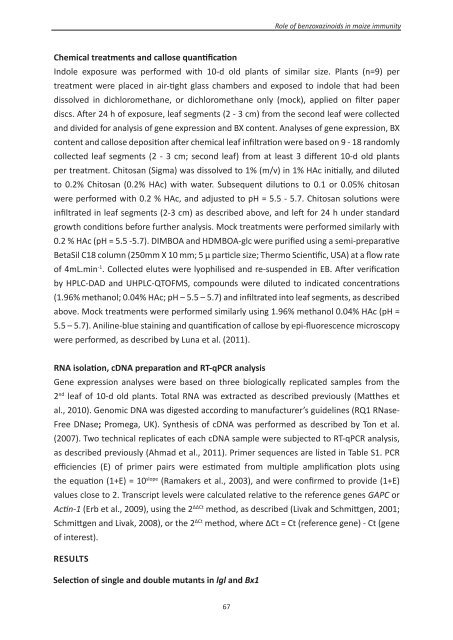Plant basal resistance - Universiteit Utrecht
Plant basal resistance - Universiteit Utrecht
Plant basal resistance - Universiteit Utrecht
You also want an ePaper? Increase the reach of your titles
YUMPU automatically turns print PDFs into web optimized ePapers that Google loves.
Chemical treatments and callose quantification<br />
67<br />
Role of benzoxazinoids in maize immunity<br />
Indole exposure was performed with 10-d old plants of similar size. <strong>Plant</strong>s (n=9) per<br />
treatment were placed in air-tight glass chambers and exposed to indole that had been<br />
dissolved in dichloromethane, or dichloromethane only (mock), applied on filter paper<br />
discs. After 24 h of exposure, leaf segments (2 - 3 cm) from the second leaf were collected<br />
and divided for analysis of gene expression and BX content. Analyses of gene expression, BX<br />
content and callose deposition after chemical leaf infiltration were based on 9 - 18 randomly<br />
collected leaf segments (2 - 3 cm; second leaf) from at least 3 different 10-d old plants<br />
per treatment. Chitosan (Sigma) was dissolved to 1% (m/v) in 1% HAc initially, and diluted<br />
to 0.2% Chitosan (0.2% HAc) with water. Subsequent dilutions to 0.1 or 0.05% chitosan<br />
were performed with 0.2 % HAc, and adjusted to pH = 5.5 - 5.7. Chitosan solutions were<br />
infiltrated in leaf segments (2-3 cm) as described above, and left for 24 h under standard<br />
growth conditions before further analysis. Mock treatments were performed similarly with<br />
0.2 % HAc (pH = 5.5 -5.7). DIMBOA and HDMBOA-glc were purified using a semi-preparative<br />
BetaSil C18 column (250mm X 10 mm; 5 µ particle size; Thermo Scientific, USA) at a flow rate<br />
of 4mL.min -1 . Collected elutes were lyophilised and re-suspended in EB. After verification<br />
by HPLC-DAD and UHPLC-QTOFMS, compounds were diluted to indicated concentrations<br />
(1.96% methanol; 0.04% HAc; pH – 5.5 – 5.7) and infiltrated into leaf segments, as described<br />
above. Mock treatments were performed similarly using 1.96% methanol 0.04% HAc (pH =<br />
5.5 – 5.7). Aniline-blue staining and quantification of callose by epi-fluorescence microscopy<br />
were performed, as described by Luna et al. (2011).<br />
RNA isolation, cDNA preparation and RT-qPCR analysis<br />
Gene expression analyses were based on three biologically replicated samples from the<br />
2 nd leaf of 10-d old plants. Total RNA was extracted as described previously (Matthes et<br />
al., 2010). Genomic DNA was digested according to manufacturer’s guidelines (RQ1 RNase-<br />
Free DNase; Promega, UK). Synthesis of cDNA was performed as described by Ton et al.<br />
(2007). Two technical replicates of each cDNA sample were subjected to RT-qPCR analysis,<br />
as described previously (Ahmad et al., 2011). Primer sequences are listed in Table S1. PCR<br />
efficiencies (E) of primer pairs were estimated from multiple amplification plots using<br />
the equation (1+E) = 10 slope (Ramakers et al., 2003), and were confirmed to provide (1+E)<br />
values close to 2. Transcript levels were calculated relative to the reference genes GAPC or<br />
Actin-1 (Erb et al., 2009), using the 2 ΔΔCt method, as described (Livak and Schmittgen, 2001;<br />
Schmittgen and Livak, 2008), or the 2 ΔCt method, where ΔCt = Ct (reference gene) - Ct (gene<br />
of interest).<br />
RESULTS<br />
Selection of single and double mutants in lgl and Bx1

















